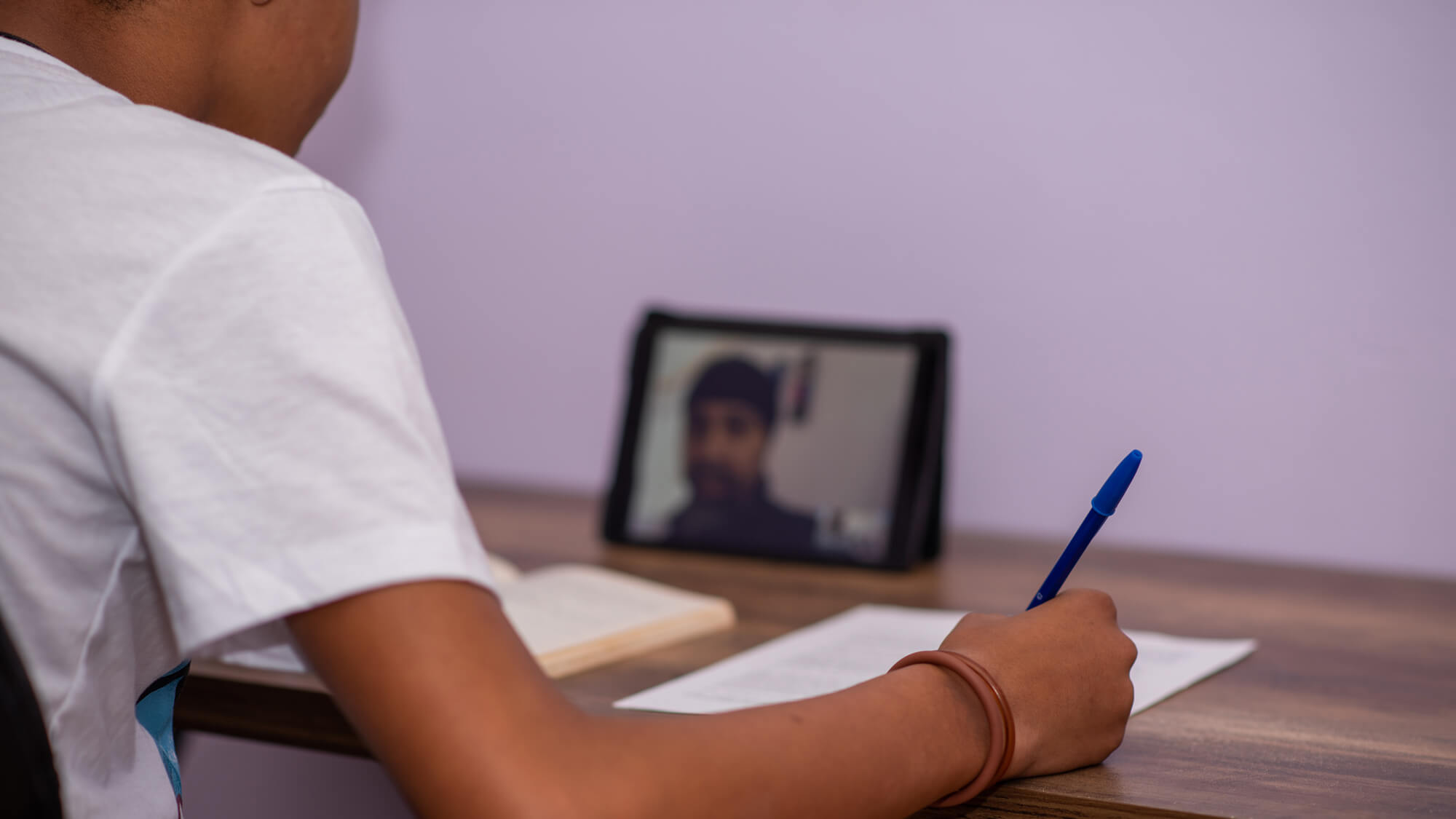How Do We Address Cheating in Remote Education?
February 01, 2021 :: Admissionado Team
Imagine, for a moment, that you are about to take the most important test of your life. For some, that might be the SAT. Others, the GMAT. It could be any test from the alphabet soup of career stakes and endless stress. For the purposes of this example, let’s pretend that the test is the LSAT, and that your aspirations rest in law school.
You’ve been studying for months on end, doing logic game after logic game, until you’re finally ready to take the big step and get it over with. You’ve signed up online, received your calendar and selected your test date, and now all you have to do is make it through one (and hopefully only one) more test, this time with the clock ticking for real.
As you sit down on the fateful day, you are not in a classroom filled with other quaking lawyers-to-be. After all, it’s 2021, and that means—well, you know what that means. Instead, you’re in the same place you’ve spent the last year: plopped at your desk chair, in your bedroom, with a barely-socially-acceptable top and only underwear below.
First, you have to download a special test-taking software that gives a virtual proctor, a disembodied stern voice, complete control of your computer screen and webcam (better neaten up that desktop). Soon after that, you are asked to shift the viewing angle of the webcam in a 360-degree panorama around the room. Perhaps your webcam is a part of your monitor, which means you have to physically lift the screen up, careful not to accidentally disconnect it from input (or power altogether) and risk completely botching this testing round. Not only do you have to swivel the camera left and right, but you also must reveal your desk (which is allowed nothing more than five sheets of scrap paper and a pencil) and beneath your desk. Then, you must visibly seclude your phone, so that any attempt to retrieve it will be immediately clear to the proctor.
Once the test begins, if you leave the webcam’s field of view, your test is cancelled. And when you finish the test, at long last, you must shred your scrap paper in front of the webcam.
Why such intense, strict procedures? Well, to stop the cheaters of course.
Cheating in the Age of COVID-19
The truth is, aside from this particularly stressful initiation process for taking at-home standardized tests, many students actually prefer this new status quo for honest reasons: not having to worry about logistics of getting to the testing site, less fear of being late, and—depending on one’s personal setup—the increased physical and psychological comfort of being at one’s home field (although questions of whether this can create an unequal playing field overall is another discussion entirely). There are tangible benefits to remote testing. But, as we have learned recently, there are serious drawbacks as well.
Major test makers like the College Board are reasonably well-equipped to address surface-level cheating methods in this strange era due to their significant resources. And much of the inequity that arises due to disparity in access to environments/technology conducive to taking online exams is ultimately an exaggeration of already existing modes of discrimination in the world of online testing. “Does this mean class and racial inequality affect performance on standardized tests?” The real question is “Yes, but what else is new?”
The real shift is happening at the local level, as teachers and professors struggle with administering exams and educating students without any silver-bullet answers to the myriad ways of gaming the system. Different teachers have different modes of assessing students, which means no one committee can drum up a universal way to stop the cheaters.
That’s not to say folks haven’t tried. Exam administrators everywhere are turning to online proctoring services such as Proctorio and Examity to help monitor students using a combination of video surveillance, keystroke detection, and facial recognition algorithms. Although seeing a major surge in stock and profits in 2020, such solutions have actually existed for years.
But as with any system, there are always those who aim to deceive it. And often, many of these cheaters—or the well-paid ringers hired by cheaters—are clever. Even with the strictest measures to prevent cheating, when test-takers no longer share a room with a proctor, new ways of gaming those measures are constantly under development. It’s not unlike the eternal, ever-evolving battle between hackers and cybersecurity companies.
And in some cases, the results are noticeable. At Penn this past fall, the class average for the midterm in one core class leapt to 75%, from 50% the previous year. This leaves the more honest-hearted students in a bind, especially when exams are graded on a curve: How do they compete with cheaters when only a set number of As will be awarded, without resorting to cheating themselves? And particularly at elite colleges (not to mention high schools), the pressure to succeed is high—high enough for a significant number of students to do it at any cost.
Let’s remember, the cost is real. Most schools place cheating among the highest offenses a student can commit. For good reason! Academic dishonesty dismantles the fundamental structure and purpose of our education system, and subsequently our social system (despite its imperfections). At many colleges it is grounds for instant expulsion—a more severe punishment than even some off campus criminal convictions incur. So when such a clear increase in cheating occurs, this is a big deal.
As if honest, hardworking students didn’t have enough to worry about already. Almost no one has found the online education experience to be a truly viable substitute for in-person learning; without the more naturally engaging atmosphere of sitting shoulder-to-shoulder with peers, watching a teacher make use of body language, movement through the room, and a whiteboard to convey her points, many students (particularly younger ones) find themselves frequently distracted and less absorbant of new information. It certainly doesn’t help that a computer screen is a portal into a world of useless video, image, reading, and gaming content vying for one’s attention. The inherent disadvantages of remote teaching are news to no one.
This lower capacity to learn, combined with the pressures stemming from uncertainty about how this year’s academic consequences will affect the college application process, has only driven up the likelihood of cheating—beyond the influence of its mere increase in ease.
So What Now?
Such observations may seem depressing, but they also force a deeper discussion that may actually be quite beneficial for the future of education, off- and online. We know this pandemic will eventually end, but that has no bearing on the reality that cheating needs to be addressed now. And the most effective way of addressing it, thus far, has stemmed from a reexamination of what exams are, well, examining.
Take, for example, CS50: an introduction to computer science that is perhaps the most well-known, well-advertised course for Harvard undergraduates. Starting in 2016, CS50 adopted a new class structure that shifted mostly online. Lectures were recorded as well-produced, TED Talk-style presentations oriented toward virtual viewing. More importantly, assessments shifted to an entirely take-home, open-book format. The only rule? No help from any humans.
Consequently, the tests contain problems that are more challenging and unexpected than those on a 1-hour in-person exam. Of course, policing whether someone receives help from either fellow classmates or other friends is hard—but between the fact that coding is not hard to cross-reference for plagiarism/similarities in answers and the relatively tight time schedule for the test, cheating is more difficult than one might think. And, as stated by the course’s website, the result is an exam stressing one’s “newfound comfort with the course’s material and […] ability to apply the course’s lessons to familiar and unfamiliar problems. And most problems aspire to teach something new.”
CS50 is not the only example of this method. Professors and high school teachers from all over have attempted similar strategies. Rather than structure courses around ability to memorize dates, events, formulas, or baseline question formats, instructors have pushed themselves to create questions and problems that demand true understanding of material, and the critical thinking to apply this understanding to unfamiliar territory. Problems for which everything you need to know could be laid out in front of you, yet no obvious answer exists. In a world where information is more readily available and discoverable than ever before, this kind of question format would seem better at driving at the true purpose of lower and higher education: to improve one’s ways of thinking. After all, what are the odds the 30-year-old you remembers Chapter 27 of your 10th-grade history textbook anyway?
Not to say that this solution is bulletproof—far from it. Not all academic subjects are created equal; some lend themselves better to this sort of testing format than others. Plus, someone’s communication with the outside world still needs to be monitored in order to prevent consultation with other students or with experts in the subject matter. And perhaps most importantly, some teachers are more equipped to construct these kinds of tests than others. Demanding all course instructors to create questions with the appropriate level of complexity and extrapolation is no small ask.
But the question of what exactly our education system is cultivating in our nation’s students lies at the heart of 2020’s remote cheating fiasco. Much like COVID laying bare the blatant holes in the U.S. healthcare system, the difficulty of adapting classroom testing to an online format has shown a bright light on the weaknesses in how we assess students.
There is room for optimism, however, because extreme circumstances breed faster, more effective solutions. Now that we must face the flaws of our education system head-on, this can pave the way for a far more effective one in the future—one that is less manipulable by the whims of parents with more money than other parents, one that is less easily gamed, and one that focuses on how students think rather than what they know.



